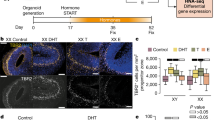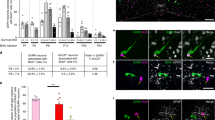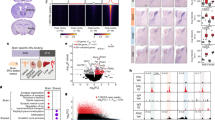Abstract
New cells, including neurons, arise in several brain regions during puberty in rats. Sex differences in pubertal addition of cells coincide with adult sexual dimorphisms: for each region, the sex that gains more cells during puberty has a larger volume in adulthood. Removing gonadal hormones before puberty eliminates these sex differences, indicating that gonadal steroids direct the addition of new cells during puberty to maintain and accentuate sexual dimorphisms in the adult brain.
This is a preview of subscription content, access via your institution
Access options
Subscribe to this journal
Receive 12 print issues and online access
$209.00 per year
only $17.42 per issue
Buy this article
- Purchase on Springer Link
- Instant access to full article PDF
Prices may be subject to local taxes which are calculated during checkout



Similar content being viewed by others
References
Cahill, L. Nat. Rev. Neurosci. 7, 477–484 (2006).
De Vries, G.J. & Simerly, R.B. in Hormones, Brain, and Behavior (Pfaff, D.W., Etgen, A.M., Fahrbach, S.E. & Rubin, R.T., eds.) 137–191 (Academic Press, San Diego, 2002).
Kokoeva, M.V., Yin, H. & Flier, J.S. J. Comp. Neurol. 505, 209–220 (2007).
Fowler, C.D., Johnson, F. & Wang, Z. J. Comp. Neurol. 489, 166–179 (2005).
Tanapat, P., Hastings, N.B., Reeves, A.J. & Gould, E. J. Neurosci. 19, 5792–5801 (1999).
Galea, L.A.M. Brain Res. Rev. 57, 332–341 (2008).
Forger, N.G. Neuroscience 138, 929–938 (2006).
Sisk, C.L. & Zehr, J.L. Front. Neuroendocrinol. 26, 163–174 (2005).
Pinos, H. et al. Brain Res. Bull. 56, 73–78 (2001).
Chung, W.C.J., De Vries, G.J. & Swaab, D.F. J. Neurosci. 22, 1027–1033 (2002).
Petersen, S.L., Ottem, E.N. & Carpenter, C.D. Biol. Reprod. 69, 1771–1778 (2003).
Hoffman, G.E., Le, W.W., Schulterbrandt, T. & Legan, S.J. Brain Res. 1054, 116–124 (2005).
Davis, E.C., Shryne, J.E. & Gorski, R.A. Neuroendocrinology 63, 142–148 (1996).
Lenroot, R.K. & Giedd, J.N. Neurosci. Biobehav. Rev. 30, 718–729 (2006).
Killgore, W.D.S. & Yurgelun-Todd, D.A. Percept. Mot. Skills 99, 371–391 (2004).
Acknowledgements
The technical support of J. Venier and L. Rogers is gratefully acknowledged. We thank M. Holmes for her technical and intellectual insight during protocol development. This work was supported by US National Institutes of Health (NIH) R01 MH-068764 (C.L.S.), F32 MH-068975 (J.L.Z.) and F31 MH-070125 (K.M.S.), the Michigan State University Foundation (C.L.S., E.I.A.), NIH R01 MH-062588 (L.L.DC.) and the Schmitt Foundation (B.H.L.).
Author information
Authors and Affiliations
Contributions
E.I.A., K.M.S. and C.L.S. designed the experiments. E.I.A., K.M.S. and J.L.Z. carried out the experiments, including BrdU injections, surgeries and single label immunocytochemistry for BrdU. E.I.A. and J.L.Z. conducted the triple-label immunocytochemistry and corresponding confocal microscopic analyses. B.H.L. and L.L.DC. performed the double-label immunocytochemistry and corresponding confocal microscopic analyses. E.I.A. wrote the initial draft of the manuscript, and C.L.S. and L.L.DC. wrote the final Brief Communication. E.I.A., K.M.S., J.L.Z. and B.H.L. prepared figures and edited each manuscript draft.
Corresponding author
Supplementary information
Supplementary Text and Figures
Supplementary Figures 1–3 and Supplementary Methods (PDF 372 kb)
Rights and permissions
About this article
Cite this article
Ahmed, E., Zehr, J., Schulz, K. et al. Pubertal hormones modulate the addition of new cells to sexually dimorphic brain regions. Nat Neurosci 11, 995–997 (2008). https://doi.org/10.1038/nn.2178
Received:
Accepted:
Published:
Issue Date:
DOI: https://doi.org/10.1038/nn.2178
This article is cited by
-
Role of Calcr expressing neurons in the medial amygdala in social contact among females
Molecular Brain (2023)
-
Sex and interspecies differences in ESR2-expressing cell distributions in mouse and rat brains
Biology of Sex Differences (2023)
-
A sex difference in mouse dopaminergic projections from the midbrain to basolateral amygdala
Biology of Sex Differences (2022)
-
The Blood–Brain Barrier: Much More Than a Selective Access to the Brain
Neurotoxicity Research (2021)



